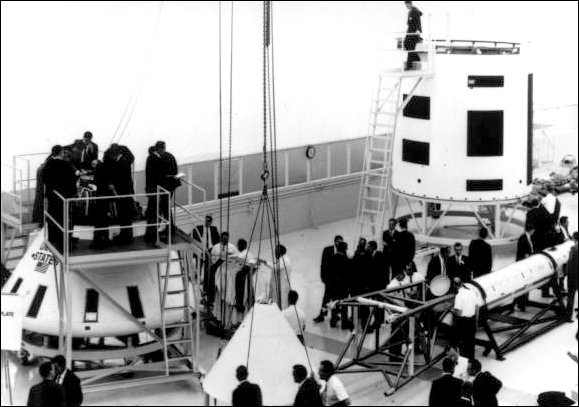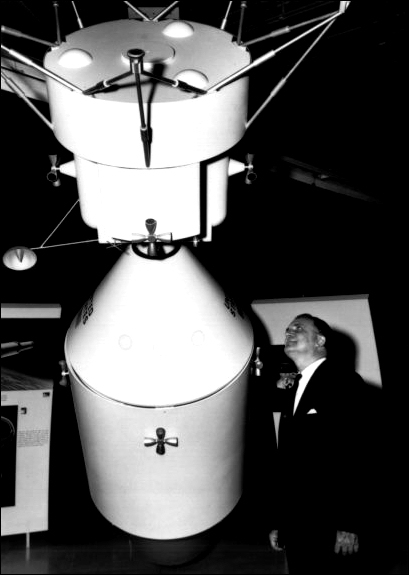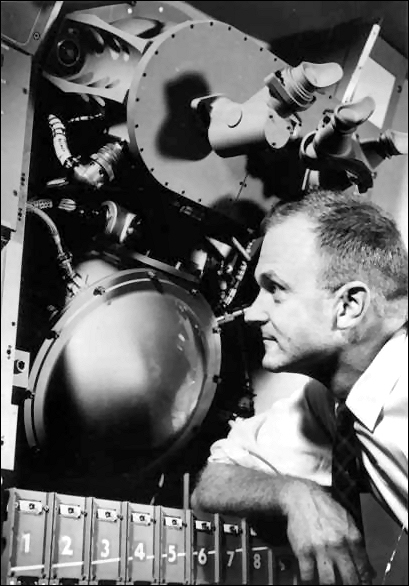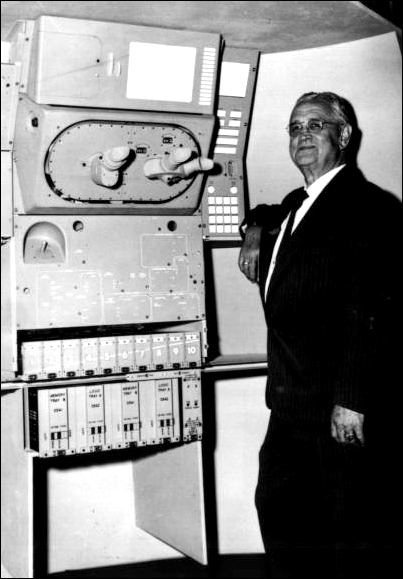Part 2 (A)
Developing Hardware Distinctions
August 30, 1963 through September 1963
1963
August
1963
September
August 30
NASA Associate Administrator Robert C. Seamans, Jr., approved
the Lunar Orbiter program. Objectives of the program were reconnaissance of the
moon's topography, investigation of its environment, and collection of
selenodetic information. (See May 12, 1964.)
The document called for five flight and three test articles. The Lunar
Orbiter spacecraft would be capable of photographing the moon from a distance of
22 miles above the surface. Overall cost of the program was estimated at between
$150 and $200 million.
NASA Office of Space Sciences (OSS) Review, "Lunar Orbiter Program Status
Report," September 4, 1963; Space Business Daily, September 3,
1963, p. 327; NASA Project Approval Document, "Research and Development Project:
Lunar Orbiter," Cost No. 84-800-804, undated; memorandum, Dir., OSS, to Langley
Research Center, Attn: Floyd L. Thompson, "Implementation of the Lunar Orbiter
Project," August 30, 1963. See also Bruce K. Byers, "Lunar Orbiter: A
Preliminary History" (NASA HHN-71, Comment Edition), p. 30.
Week of August 30
North American defined the maximum, nominal, and
minimum CM ablation heatshield thicknesses for lunar reentry. The maximum and
minimum limits represented variations that might arise as studies progressed.
MSC, "ASPO Weekly Activity Report, August 30-September 4, 1963," p. 3.
During the Month
Grumman built a full-scale cardboard model of the LEM
to aid in studying problems of cockpit geometry, specifically the arrangement of
display panels. This mockup was reviewed by MSC astronauts and the layout of the
cockpit was revised according to some of their suggestions.
Also Grumman reported that a preliminary analysis showed the reaction control
system plume heating of the LEM landing gear was not a severe problem. [This
difficulty had been greatly alleviated by the change from five to four landing
legs on the vehicle. (See April 17 and May 20-22.)]
"Monthly Progress Report No. 7," LPR-10-22, pp. 7, 25.
During the Month
At a meeting at MSC, Grumman representatives submitted
the cost proposal for LEM test articles LTA-8 and LTA-9, and suggested a testing
program for the two vehicles: LTA-8 should be used for restrained integrated
systems testing in the altitude propulsion test facilities at the Atlantic
Missile Range; LTA-9 should be used for manned atmospheric tethered operation
tests. The contractor also recommended an early flight demonstration program to
verify the helicopter tether operation potential, which promised greatly
increased mission test capability over fixed-base tether facilities. The tether
method (helicopter or fixed- base) should be determined after the verification.
LTA-8 should be considered as a constraint to LEM-5, and LTA-9 as a constraint
to the lunar landing mission.
Ibid., pp. 45, 46.
MSC reported that design of the control
and displays panel for the CM was about 90 percent complete. North American was
expected to release the design by September 20. Qualification testing of the
panels would begin around December 1.
MSC, "Weekly Activity Report for the Office of the Director, Manned Space
Flight, September 1-7, 1963," p. 3.
September 4
Director Robert R. Gilruth established the MSC Manned
Spacecraft Criteria Board to set up engineering, design, and procedural
standards for manned spacecraft and associated systems. The board was composed
of Maxime A. Faget, Chairman; James A. Chamberlin; Kenneth S. Kleinknecht; F.
John Bailey, Jr.; G. Barry Graves; Jacob C. Moser; and Norman F. Smith,
Secretary. Board criteria would become MSC policy; and - unless specific waivers
were obtained, compliance by project offices was mandatory.
MSC Circular No. 85, "MSC Manned Spacecraft Criteria Board," September 17,
1963.
September 4
MSC Flight Operations Division (FOD) recommended a series of
water impact tests to establish confidence in the CM's recovery systems under a
variety of operating conditions. FOD suggested several air drops with water
landings under various test conditions. Among these were release of the main
parachutes at impact, deployment of the postlanding antennas, actuation of the
mechanical location aids, and activation of the recovery radio equipment.
Memorandum, Christopher C. Kraft, Jr., MSC, to Mgr., ASPO, "Recommendation
for a water landing operational qualification test series using AFRM 005,"
September 4, 1963.
September 5-11
MSC began a study to define the stability limits of a
457-centimeter (180inch) radius LEM gear configuration. The study, in two
phases, sought to examine factors affecting stability (such as lunar slope,
touchdown velocity and direction, and the effects of soil mechanics) in direct
support of the one-sixth model and full-scale drop test programs and to complete
definition of landing capabilities of the LEM. (See October 2.)
MSC, "ASPO Weekly Activity Report, September 5-11, 1963," pp. 7-8.
September 6
MSC announced a $7.658 million definitive contract with
Kollsman Instrument Corporation for the CM guidance and navigation optical
equipment, including a scanning telescope, sextant, map and data viewer, and
related ground support equipment. MSC had awarded Kollsman a letter contract on
May 28, 1962, and had completed negotiations for the definitive contract on
March 29, 1963. "The newly signed contract calls for delivery of all hardware to
AC Spark Plug by August 1, 1964."
MSC News Release 63-147, September 6, 1963; MSC, "Weekly Activity Report for
the Office of the Director, Manned Space Flight, May 27-June 3, 1962," p. 12;
Kollsman Instrument Corporation, "Apollo Program Quarterly Progress Report No.
3," March 31, 1963, p. 2; ibid., "Apollo Program Quarterly Progress
Report No. 6," December 31, 1963, pp. 10-11.
September 6
MSC Flight Operations Division (FOD) established a 72-hour
lifetime for Apollo recovery aids. This limitation was derived from
considerations of possible landing footprints, staging bases, and aircraft range
and flying time to the landing areas. Primary location aids were the spacecraft
equipment (VHF AM transceiver, VHF recovery beacon, and HE transceiver) and the
VHF survival radio. Because of battery limitations, current planning called for
only a 24-hour usage of the VHF recovery beacon. If electronic aids were needed
beyond this time the VHF survival radio would be used. If the spacecraft were
damaged or lost, the VHF survival radio would be the only electronic location
aid available. MSC had recently selected the Sperry Phoenix Company to produce
the Gemini VHF survival radio, which was expected to meet the Apollo
requirements. FOD recommended that the current contract with Sperry Phoenix be
extended to provide the units needed for Apollo missions.
Memorandum, Christopher C. Kraft, Jr., MSC, to ASPO, Attn: L. N. McMillion,
"Apollo VHF survival radio," undated (ca, September 1963).
September 6
At El Centro, Calif., CM boilerplate (BP) 3, a parachute
test vehicle, was destroyed during tests simulating the new BP-6 configuration
(without strakes or apex cover). Drogue parachute descent, disconnect, and pilot
mortar fire appeared normal. However, one pilot parachute was cut by contact
with the vehicle and its main parachute did not deploy. Because of harness
damage, the remaining two main parachutes failed while reefed. Investigation of
the BP-3 failure resulting in rigging and design changes on BP-6 and BP-19.
"Apollo Monthly Progress Report," SID 62-300-17, p. 11; ibid.,
SID 62-300-18, pp. 15-16.
September 9
MSC ordered North American to make provisions in the CM to
permit charging the 28-volt portable life support system battery from the
spacecraft battery charger.
On the following day, the Center informed North American also that a new
mechanical clock timer system would be provided in the CM for indicating elapsed
time from liftoff and predicting time to and duration of various events during
the mission.
Letter, H. P. Yschek, MSC, to NAA, Space and Information Systems Div.,
"Contract Change Authorization No. Eighty-Two," September 9, 1963;
ibid., "Contract Change Authorization No. Eighty-Four," September
10, 1963.

A design engineering inspection (DEI) and Apollo program design review
were held at NAA's El Segundo, Calif., facilities September 10-12, 1963. About
70 NASA personnel members participated in the DEI of boilerplate 12 before it
was shipped to WSMR to test the launch escape system. The following two days
approximately 100 NASA employees including personnel from most NASA Centers and
Headquarters attended the program design review. Topics included structural
design, the propulsion, power, and electrical systems, guidance and navigation,
simulation and trainers, ground support equipment, and a program hardware
summary.
September 12
NASA announced that, in the future, unmanned lunar landing
spacecraft e.g., Rangers and Surveyors) will be assembled in "clean rooms" and
treated with germ-killing substances to reduce the number of microbes on exposed
surfaces. These sterilization procedures, less stringent than earlier methods,
were intended to prevent contamination of the lunar surface and, at the same
time, avoid damage to sensitive electronic components. Heat sterilization was
suspected as one of the reasons for the failure of Ranger spacecraft.
The Washington Post, September 13, 1963.
September 16
A tone warning signal was added to the CM instrumentation
system. If a system malfunctioned, this warning would be heard through both the
master caution and warning subsystem and the astronauts' earphones.
Letter, H, P. Yschek, MSC, to NAA, Space and Information Systems Div.,
"Contract Change Authorization No. Eighty-Nine," September 16, 1963.
September 16
The launch escape system was modified so that, under normal
flight conditions, the crew could jettison the tower. On unmanned Saturn I
flights, tower jettison was initiated by a signal from the instrument unit of
the S-IV (second) stage.
Letter, H. P. Yschek, MSC, to NAA, Space and Information Systems Div.,
"Contract Change Authorization No. Ninety-One," September 16, 1963.
September 16-18
NASA representatives held a formal review of Grumman's
LEM M-1 mockup, a full-scale representation of the LEM's crew compartment. MSC
decided that (1) the window shape (triangular) and visibility were satisfactory;
(2) a standing position for the crew was approved, although, in general, it was
believed that restraints restricted crew mobility; (3) the controllers were
positioned too low and lacked suitable arm support for fine control; and (4)
crew station arrangement was generally acceptable, although specific details
required further study. (See June 16-July 20 and August 27.)
MSC, "ASPO Weekly Status Report, September 19-25, 1963."
September 17
LTV presented the preliminary results of a manual
rendezvous simulation study. Their studies indicated that a pilot trained in the
technique could accomplish lunar launch and rendezvous while using only two to
three percent more fuel than the automatic system. (See May 6 and October 10,
1963, and April 24, 1964.)
MSC, "Consolidated Activity Report for the Office of the Director, Manned
Space Flight, September 22-October 19, 1963," p. 31.
September 18
The AiResearch Manufacturing Company announced that it had
been awarded a $20 million definitive contract for the CM environmental system.
[AiResearch had been developing the system under a letter contract since 1961.
See Volume I, December 21, 1961.]
The Houston Post, September 19, 1963.
September 19
MSC made several changes in the CM's landing requirements.
Impact attenuation would be passive, except for that afforded by the crew
couches and the suspension system. The spacecraft would be suspended from the
landing parachutes in a pitch attitude that imposed minimum accelerations on the
crew. A crushable structure to absorb landing shock was required in the aft
equipment bay area.
Letter, H. P. Yschek, MSC, to NAA, Space and Information Systems Div.,
"Contract Change Authorization No. Ninety-Three," September 19, 1963.
September 19-25
The space suit umbilical disconnects were being
redesigned to the "buddy concept" and for interchangeability between the CM and
the LEM. (See September 29, 1964.) MSC was reviewing methods for a crewman to
return to the LEM following space suit failure on the lunar surface. (See July
28August 3.)
MSC, "ASPO Weekly Activity Report, September 19-25, 1963," p. 4.
September 19-25
North American incorporated an automatic radiator
control into the CM's environmental control system to eliminate the need for
crew attention during lunar orbit.
Recent load analysis at North American placed the power required for a 14-day
mission at 577 kilowatt-hours, a decrease of about 80 kilowatt-hours from
earlier estimates.
Ibid., pp. 2, 3.
September 19-October 16
Grumman directed Bell Aerosystems Company to
establish the ablative nozzle extension as the primary design for the LEM's
ascent stage engine. The radiation-cooled nozzle design, a weight-saving
alternative, must be approved by NASA. See March; also January and May 4-11,
1964.
MSC, "ASPO Monthly Activity Report, September 19-October 16, 1963," p. 18.
September 20
President John F. Kennedy, during an address before the
United Nations General Assembly, suggested the possibility of Russian-American
"cooperation" in space. Though not proposing any specific program, Kennedy
stated that, "in a field where the United States and the Soviet Union have a
special capacity - the field of space - there is room for new cooperation, for
further joint efforts in the regulation and exploration of space. I include
among these possibilities," he said, "a joint expedition to the moon. . . .
Surely we should explore whether the scientists and astronauts of our two
countries - indeed, of all the world - cannot work together in the conquest of
space, sending some day in this decade to the moon, not the representatives of a
single nation, but the representatives of all humanity."
During a news conference in Houston that same day, several NASA officials
commented on the President's address. Associate Administrator Robert C. Seamans,
Jr., stated that Kennedy's proposals came as no great surprise. He said that
many "large areas" for cooperation exist, such as exchanges of scientific
information and in space tracking, but emphasized that no cosmonauts would be
flying in Apollo spacecraft. Deputy Associate Administrator George E. Mueller
shared Seamans' views, comparing future U.S.-U.S.S.R. cooperation in space to
joint explorations in Antarctica. Scientists from both nations work together,
but "they get there in different ships." Just three days earlier, MSC Director
Robert R. Gilruth had told the National Rocket Club that a joint
American-Russian space flight - especially one to the moon - would present
almost insuperable technological difficulties. "I tremble at the thought of the
integration problems . . . ," he said. Gilruth cautioned his audience that he
was speaking "not as an international politician," but as an engineer. The task
of mating American and Russian spacecraft and launch vehicles would make such
international cooperation "hard to do in a practical sort of way." And at the
September 20 MSC news conference he added that such problems "are very difficult
even when they [hardware components] are built by American contractors."
Robert L. Rosholt, An Administrative History of NASA, 1958-1963
(NASA SP-4101), p. 288; Astronautics and Aeronautics, 1963, pp.
343, 347; The Houston Chronicle, September 19, 20, 21, 1963.
September 22-29
North American checked out the test fixture that was
slated for the astronaut centrifuge training program, resolving interfaces
between test fixture, centrifuge, and the test conductor's console, and
familiarizing astronauts with controls and displays inside the spacecraft.
On October 1, North American delivered the test fixture to the U.S. Navy
Aviation Medical Acceleration Laboratory, where the first phase of the manned
centrifuge program was scheduled to begin that month.
"Apollo Monthly Progress Report," SID 62-300-48, pp. 4-5; MSC, "ASPO Weekly
Activity Report, October 3-9, 1963," p. 3.
September 24
MSC advised North American that the television camera in
the CM was being modified so that ground personnel could observe the astronauts
and flight operations. Television images would be transmitted directly to earth
via the Deep Space Instrumentation Facility.
Letter, H. P. Yschek, MSC, to NAA, Space and Information Systems Div.,
"Contract Change Authorization No. Ninety-Five," September 24, 1963.

NASA Administrator James E. Webb examined a docked configuration of the
Apollo spacecraft model during a visit to Houston September 24, 1963.
September 25-26
MSC representatives reviewed Grumman's program for
thermal testing for the LEM, to be conducted with the test model 2 (TM-2)
vehicle. Because the vehicle's configuration had changed so extensively, the
Center canceled the currently planned TM-2 ascent stage and ordered another
stage to be substituted. TM-2's descent stage needed only small design changes
to make it suitable for the program.
MSC," ASPO Weekly Activity Report, September 26-October 2, 1963," p. 12.
September 26
At a meeting at MSC, Grumman representatives presented 18
configurations of the LEM electrical power system, recommending a change from
three to two fuel cells, still supplemented by an auxiliary battery system, with
continued study on tankage design. On December 10, ASPO authorized the
contractor to proceed with this configuration.
Letter, Owen E. Maynard, MSC, to GAEC, Attn: R. S. Mullaney, "Contract NAS
9-1100, Electrical Power Subsystem Configuration Recommendation," December 10,
1963; MSC, "ASPO Weekly Activity Report, September 26- October 2, 1963," p. 11.
September 26
OMSF, MSC, and Bellcomm representatives, meeting in
Washington, D.C., discussed Apollo mission plans: OMSF introduced a requirement
that the first manned flight in the Saturn IB program include a LEM. ASPO had
planned this flight as a CSM maximum duration mission only.
- Bellcomm was asked to develop an Apollo mission assignment program without
a Saturn I.
- MSFC had been asking OMSF concurrence in including a restart capability in
the S-IVB (second) stage during the Saturn IB program.
ASPO would agree
to this, but only if the H-1 engine were uprated from 85,275 to 90,718 kilograms
(188,000 to 200,000 pounds) of thrust, resulting in a 907-kilogram (2,000-pound)
payload gain.
MSC, "ASPO Weekly Activity Report, September 26-October 2, 1963."
September 26-27
MSC representatives visited Grumman for a preliminary
evaluation of the Apollo space suit integration into the LEM. A suit failure
ended the exercise prematurely. Nonetheless, leg and foot mobility was good, but
the upper torso and shoulder needed improvement.
On October 11, MSC Crew Systems Division (CSD) tested the suit's mobility
with the portable life support system (PLSS). CSD researchers found that the
PLSS did not restrict the wearer's movement because the suit supported the
weight of the PLSS. Shifts in the center of gravity appeared insignificant. The
PLSS controls, because of their location, were difficult to operate, which
demanded further investigation.
Ibid.; MSC, "Consolidated Activity Report for the Office of the
Director, Manned Space Flight, September 22-October 19, 1963," p. 48.
September 26-October 2
North American recommended that the portable life
support system in the CM be deleted. Current planning placed two units in the
LEM and one in the CM.
MSC, "ASPO Weekly Activity Report, September 26-October 2, 1963," p. 3.
September 30
MSC awarded Texas Instruments, Inc., a $194,000 contract to
study experiments and equipment needed for scientific exploration of the lunar
surface. The analysis was to be completed by the end of May 1964. (See March 17,
1964.)
MSC, "Consolidated Activity Report for the Office of the Director, Manned
Space Flight, September 22-October 19, 1963," p. 41; "Apollo Quarterly Status
Report No. 6," p. 34; MSC News Release 63-171, October 16, 1963.
September 30
Qualification testing began on fuel tanks for the service
propulsion system (SPS). The first article tested developed a small crack below
the bottom weld, which was being investigated, but pressurization caused no
expansion of the tank. During mid-October, several tanks underwent proof
testing. And, on November 1, the first SPS helium tank was burst-tested.
MSC, "ASPO Status Report for Period Ending October 16, 1963"; "ASPO Status
Report for Period October 16-November 12, 1963"; "ASPO Status Report for Period
Ending October 23, 1963."

David G. Hoag, technical director of the Apollo guidance and navigation
system design program at MIT's Instrumentation Laboratory, inspected a mockup of
the inertial measurement unit in the system.

Director of the Laboratory Dr. C. Stark Draper posed beside a mockup of
the guidance and navigation system.
During the Month
The interrelationships between all major LEM test
vehicles, including all test constraints and documentation requirements, were
developed. This logic study, prepared by Grumman and forwarded to MSC, stressed
the feasibility of alterations in the LEM test program as needed.
"Monthly Progress Report No. 8," LPR-10-24, p. 45.










